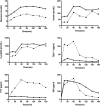Roux-en-Y Gastric Bypass Surgery in the Management of Familial Partial Lipodystrophy Type 1
- PMID: 28973478
- PMCID: PMC5630252
- DOI: 10.1210/jc.2017-01235
Roux-en-Y Gastric Bypass Surgery in the Management of Familial Partial Lipodystrophy Type 1
Abstract
Context: Familial partial lipodystrophy type 1 (FPLD1) is an extreme form of central adiposity, with peripheral lipodystrophy associated with severe manifestations of the metabolic syndrome, often poorly responsive to standard therapeutic approaches. Body mass index in FPLD1 varies but, in many cases, is below the level at which metabolic surgery is usually considered as a therapeutic option.
Design: We detailed the metabolic response to gastric bypass surgery of three patients with FPLD1, refractory to medical therapy.
Results: Roux-en-Y gastric bypass (RYGB) was associated with weight loss and substantial improvements in glycemic control and insulin sensitivity. All three patients were able to stop using insulin. Glucose tolerance testing in one patient demonstrated an increase in L-cell-derived gut hormone responses postoperatively.
Conclusion: RYGB surgery substantially improved glycemic control in three patients with FPLD1, two of whom had body mass indices below 30 kg/m2. RYGB should be considered in patients with partial lipodystrophy and refractory metabolic disease.
Copyright © 2017 Endocrine Society
Figures


References
-
- Brown RJ, Araujo-Vilar D, Cheung PT, Dunger D, Garg A, Jack M, Mungai L, Oral EA, Patni N, Rother KI, von Schnurbein J, Sorkina E, Stanley T, Vigouroux C, Wabitsch M, Williams R, Yorifuji T. The diagnosis and management of lipodystrophy syndromes: a multi-society practice guideline. J Clin Endocrinol Metab. 2016;101(12):4500–4511. - PMC - PubMed
Publication types
MeSH terms
Grants and funding
LinkOut - more resources
Full Text Sources
Other Literature Sources
Medical
Research Materials

